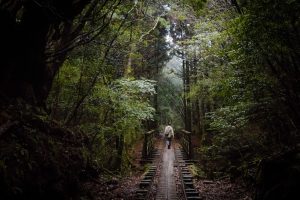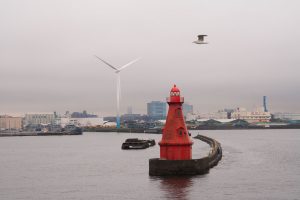In the northwestern part of Kyoto city, near Kinugasa Hill, lies a unique art museum dedicated to the works of Insho Domoto. It was founded in 1966 by the artist himself, who was active during the Taisho and Showa periods. In the last years of his life, Domoto built this museum to house his works.
Both the interior and exterior were conceived by Domoto in the image of a ship. He designed everything himself, from the chairs to the doorknobs to the window bars. He also painted the ceilings and screen doors. The entire museum, in itself, is a piece of art. After Domoto’s death, it was donated to Kyoto Prefecture. It opened in 1992 as the Insho-Domoto Museum of Fine Arts.
Born in Kyoto to a family of sake merchants, Domoto was originally known as Sannosuke. He began working from a young age for the textile artist, Heizo Tatsumura I. After graduating from the Kyoto City School of Arts and Crafts in 1910, he started drawing patterns for traditional textiles known as Nishijin-ori.


Domoto went on to study Nihonga at the Kyoto City School of Painting. Nihonga, which literally means, “pictures of Japan,” is a style that uses mineral pigments, and sometimes ink, on silk or paper. When it was coined during the Meiji period, it was used to differentiate from works of yōga, or western-style painting.
In 1919, at the age of 28, Domoto made his debut as a painter at the Imperial Academy of Fine Art Exhibition. His work, Landscape of Fukakusa, depicted a village farming scene with pigment on a two-panel silk folding screen. Six years later, his painting, “Kegon” was awarded the Grand Prix.
Domoto began to receive commissions from Buddhist temples in the area for his large-scale works. He went on to paint more than 600 screens and ceilings for temples and shrines. He later established his own painting school, which still exists today, and taught at the Kyoto Municipal Special School of Painting.



Domoto was primarily a Nihonga painter but refused to be pigeonholed into one genre. It was his philosophy that as soon as an artist had perfected one style, he should move swiftly onto the next. As a result, the museum houses all kinds of creations of his, including ceramics, metalwork, and textiles. The entire collection comprises about 2,600 pieces, which are regularly rotated in themed exhibitions. Special exhibitions are also held annually to showcase the work of other Nihonga artists.
All the exhibition info is in Japanese, but it’s worth a trip just to see the building alone. And since the museum is a short distance from both Kinkaku-ji and Ryoan-ji, it can easily be combined with a visit to either temple. The museum also has a small gift shop and garden to explore, and an outdoor rest area where you can take a breather in nice weather.

Visit the Insho Domoto Museum
There is a bus stop right outside the museum (Ritsumeikan Daigaku-mae) which is easily accessible from Kyoto Station, Kinkaku-ji Temple, and Ryoan-ji Temple. It takes about 50 minutes to get there from Kyoto Station, 8 minutes from Kinkaku-ji, and only 1 minute from Royan-ji. You can also walk from either temple and be there in 10-15 minutes.
Hours: 09:30~17:00 (closed Mondays)
Admission: ¥510





1 Comment
Join the discussion and tell us your opinion.
Looks interesting, great photos as always